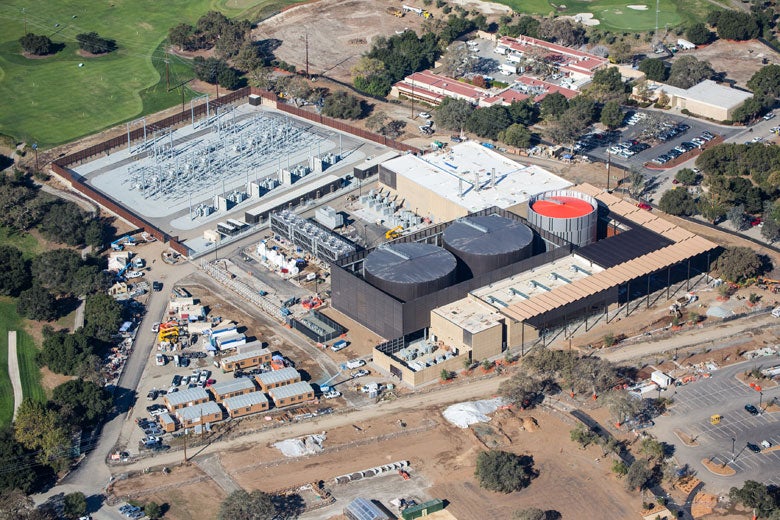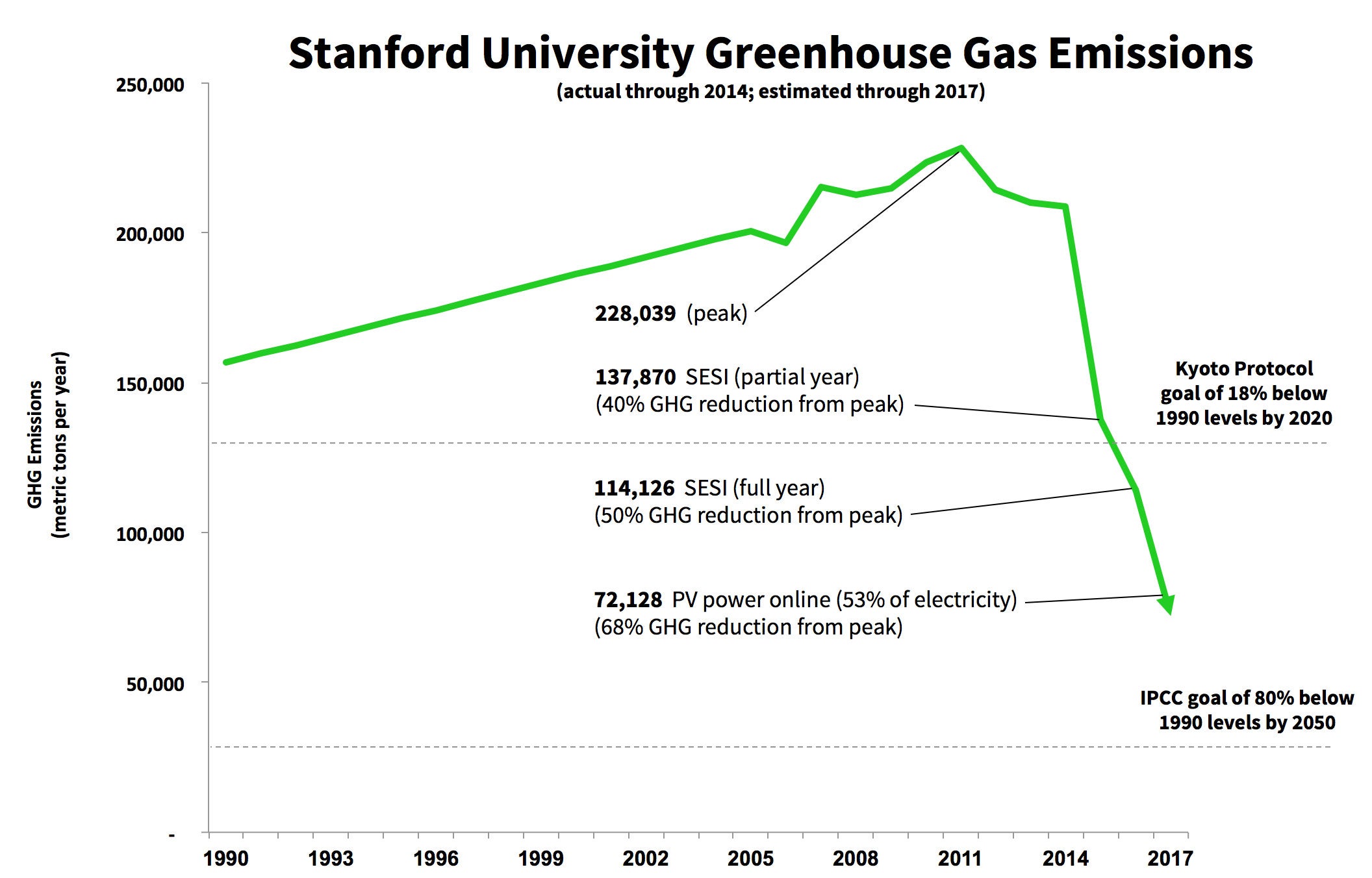
Aerial view shows the Central Energy Facility as it nears completion in November 2014. The facility is a key part of Stanford Energy System Innovations, a campus energy system that makes Stanford one of the most energy-efficient research universities in the world. (Image credit: Todd Quam)
In late November and early December, global leaders and thousands of others will gather in Paris for a much-anticipated United Nations conference on climate change.
The COP21 – the 21st gathering of the “Conference of the Parties” to the 1992 U.N. Framework Convention on Climate Change – will seek a new international climate agreement, aiming to keep global warming to no more than 2 degrees Celsius above pre-industrial levels.
On behalf of the Stanford Board of Trustees, Board Chair Steven A. Denning and Stanford President John Hennessy have issued a statement to the summit conveners, urging global leaders to look to universities for climate solutions. The statement highlights the steps Stanford has taken to provide leadership on climate change, both in its academic enterprise and in its operations, and welcomes dialogue and idea-sharing with other universities.
The statement highlights Stanford’s innovative new campus energy system, which will reduce campus greenhouse gas emissions by 68 percent and allow Stanford to exceed state, national and international energy goals for 2020 several years early. The statement also describes research breakthroughs, energy upgrades and sustainability initiatives the Stanford community has achieved in recent years.
“Climate change is one of the most significant issues of our time, and the Paris summit is a key moment in the global search for sustainable solutions,” Denning said. “Our students and faculty are actively addressing the climate challenge, and Stanford itself has taken a leadership role in finding, modeling and implementing solutions. The Paris summit is an important opportunity to convey the imperative for universities to play a central role in this effort and to share what Stanford is doing in its operations, its teaching and its research to address sustainability.”
The text of the letter follows below and is available in pdf here.
October 28, 2015
Laurent Fabius
Minister of Foreign Affairs and International Development, Government of France
President, COP21 Conference
37, Quai d’Orsay 75007
Paris, France
Dear Mr. Fabius:
As the 2015 Paris Climate Conference approaches, on behalf of Stanford University we write to urge the global leaders participating in COP21 to look to our world’s research universities for solutions to climate change. The magnitude of the climate challenge calls for action on the part of all institutions. Universities have a special role to play, both as knowledge centers that develop technological and policy innovations and as large organizations that have the opportunity to model sustainable operational practices.
At Stanford, we have put our beliefs about the importance of sustainability into practice. We are now completing a transformative $500 million campus energy system that will reduce campus greenhouse gas emissions by 68 percent by the end of 2016 and allow us to exceed state, national and international energy goals for 2020 several years early. We soon will achieve a 36 percent reduction in potable water use. And these operational milestones are matched by years of cutting-edge research and interdisciplinary academic leadership, advanced significantly by a campus-wide initiative on the environment and sustainability launched more than a decade ago.
Our students are contributing great energy to this cause, and we are inspired by their commitment and passion. They recognize climate change as a critical issue for their generation and for the world – a cause that goes well beyond themselves to the health and well-being of our global community. Their voices are important to the discussion. Indeed, both students and faculty from Stanford will be joining you in Paris for COP21.
Dialogue and information exchange are crucial to our collective efforts internationally to address climate change. In the spirit of sharing practices that move us toward common goals, we would like to present briefly some of the Stanford community’s work in this area. We are gratified to have hosted visitors from around the world to see some of our initiatives in action, and we welcome others interested in learning about our work and sharing their own ideas.
New energy system: The International Energy Agency has outlined a new recommended “roadmap” for heating and cooling using low-carbon technologies. Stanford has implemented such a system on a large scale, and it represents a complete transformation of our campus energy system into one of the most energy-efficient systems in the world.
The first component, the Stanford Energy System Innovations (SESI), eliminates a fossil fuel-based cogeneration plant that previously supplied heat and power for our campus. Recognizing that Stanford’s facilities have a 70 percent overlap of heating and cooling demands, the new system employs an innovative heat recovery system. The system collects waste heat from buildings needing cooling via a chilled-water loop, captures it at a central energy facility, then distributes it to buildings needing heat through a hot-water loop. This project, completed in 2015, involved fundamentally reimagining our energy system and laying 22 miles of pipeline underneath our campus. Stanford’s $485 million investment in the system is projected to save $420 million in costs over 35 years.
In addition, Stanford is aggressively moving into solar energy. An off-site solar plant is currently being built in Southern California, and additional solar panels will be mounted on 19 campus buildings. Together, these new solar energy sources will provide 53 percent of Stanford’s electricity. The remainder of Stanford’s energy, purchased from outside sources, includes at least 25 percent from renewable sources, a proportion growing over time under California law. By the end of 2016 Stanford will be obtaining 65 percent of its power from renewable sources, and that proportion will continue to increase.
These two components – SESI and a major new photovoltaic system – together will reduce campus greenhouse gas emissions by 68 percent from our 2011 peak levels and will reduce consumption of potable water by 15 percent. Coupled with previous water-saving efforts, Stanford’s potable water consumption will have decreased 36 percent since 2000.
Our greenhouse gas reduction will exceed all state, federal and international energy goals (including the Kyoto Protocol goal of an 18 percent reduction below 1990 levels by 2020) several years early. And we are well on the path to meeting the 2050 goal of the Intergovernmental Panel on Climate Change for an 80 percent reduction of greenhouse gas emissions from 1990 levels. The following graph demonstrates our progress:

Click image to enlarge. (Image credit: John Holleman)
Research and teaching: The business of universities is the creation and dissemination of knowledge. For years, Stanford has pursued the kind of interdisciplinary research and education that is particularly required for finding sustainable solutions to global challenges such as climate change, bringing together scholars from different fields to focus on big problems. Today we offer more than 750 undergraduate and graduate courses, across all seven of our schools, addressing sustainability issues. Interdisciplinary institutes such as the Stanford Woods Institute for the Environment, the Precourt Institute for Energy, and the Steyer-Taylor Center for Energy Policy and Finance bring together scholars to develop climate solutions and forge connections among academic, governmental, NGO and business leaders to effectuate them in the world. Students play an active role through research, internships, fellowships and student organizations in addition to coursework – preparing them to be the climate leaders our world will need in the coming generations.
Stanford researchers have played key roles leading the U.N. Intergovernmental Panel on Climate Change Fifth Assessment Report; exploring the connections between climate change and drought; developing approaches to reducing greenhouse gas emissions from land use and agriculture; identifying strategies for increasing solar efficiency and the performance of batteries; modeling the feasibility of converting our energy infrastructure to one powered by clean energy; mapping vulnerabilities of people and places to climate change impacts and developing approaches for increasing resilience; examining new approaches to global climate policy; and engaging in countless other activities that have advanced understanding of the climate challenge and possible solutions.
Transportation: Stanford has implemented an aggressive set of incentives to encourage the use of alternative transportation, resulting in reduced air pollution, traffic congestion and fuel consumption. These incentives include free train and bus passes for employees; a “Commute Club” that provides cash rebates to employees who do not drive to work; incentives for carpooling, vanpooling and bicycling to campus; one of the largest university Zipcar programs in the United States; and a free campus shuttle system that links to regional transit systems.
As a result, from 2002 to 2014, the percentage of Stanford employees driving alone to work has dropped from 72 percent to 49 percent – despite the university’s suburban location within the traffic-intensive San Francisco Bay Area. We also are working to move away from gasoline-powered vehicles. Stanford’s free shuttle service consists of 13 electric buses, five diesel-electric hybrid buses, and 53 biodiesel and renewable diesel buses. Nearly one-third of Stanford’s 1,049 fleet vehicles are electric, and the number of hybrid vehicles is increasing each year. Meanwhile, the university has built 16 electric-vehicle charging stations on campus and has plans for 50 more in 2016.
Building energy efficiency: In addition to the greenhouse gas reductions being achieved through its new energy system, Stanford has avoided another 8 percent of emissions through stringent energy standards for new buildings and through two programs that renovate existing Stanford buildings for energy efficiency.
Our Energy Retrofit Program has saved more than 240 million kilowatt-hours of electricity since 1993 – roughly equivalent to 15 months of the university’s electricity use. This rebate program promotes energy efficiency through technology upgrades in campus buildings, including LED lighting, high-efficiency air compressors and lab freezers, and other efforts that save electricity or thermal energy. There have been more than 500 retrofits to campus buildings through this program since it began in 1993.
In addition, Stanford has allocated $30 million for major capital improvements to the most energy-intensive buildings on campus through its Whole Building Energy Retrofits Program. So far 15 of these projects have been completed and 12 more are in the pipeline. These retrofits have saved more than $4 million per year in operational costs.
* * *
For these and other efforts, Stanford is proud to have received a Gold sustainability ranking from the Association for the Advancement of Sustainability in Higher Education. But our work is far from finished. In the period ahead, we expect to continue expanding our use of renewable energy sources, moving past the international 2020 goals to the 2050 goals. We will continue electrifying an ever-greater portion of our transportation fleet. And we will continue working with students and faculty to further expand our academic contributions while minimizing our ecological footprint. It is Stanford’s goal to remain a leader in achieving reductions in greenhouse gas emissions.
Divestment of endowment assets from fossil fuel companies is another dimension of the conversation occurring at Stanford and many other universities. For more than 40 years, Stanford has had a robust process in place to consider our community’s views on these issues, resulting in our decision last year to divest from coal companies. Currently, a community advisory panel at Stanford is reviewing another proposal with the intention of providing input to the Board of Trustees this academic year. The issues are complex, and they must be researched thoroughly and evaluated in a principled manner on a company-by-company basis, while our other initiatives to combat climate change continue in parallel.
As the COP21 participants prepare to meet in Paris, we applaud your efforts to forge a universal agreement on climate. We encourage the COP21 participants to draw on universities for inspiration and for best practices – the examples cited in this letter are indeed only examples of the extraordinary advances being made in universities around the world. And we urge all institutions, at all levels, to confront the climate challenge ambitiously and with urgency.
Sincerely,
Steven A. Denning
Chair, Board of Trustees
John L. Hennessy
President